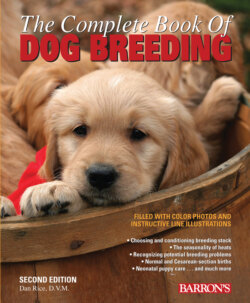Читать книгу The Complete Book of Dog Breeding - Dan Rice - Страница 16
На сайте Литреса книга снята с продажи.
Ovulation
ОглавлениеOf further importance and interest is the time of ovulation and its relationship to fertilization of the ova (eggs). According to research published by Sokoloweski in 1977, there are about 700,000 ova present in a bitch’s ovaries prior to puberty (see References, page 178). By the time of her second or third heat, a quarter of a million remain. A rather large number of these eggs are expelled from ovarian follicles during each estrus. That expulsion of ova from her ovaries is called ovulation.
TIP
Be skeptical of literature or old wives’ tales about breeding on specific days of the estrous cycle. Forced breeding or artificial insemination of a bitch on an arbitrarily assigned day may be doomed to failure.
Ovulation is spontaneous in the bitch; all mature ovarian follicles rupture at the same time, releasing their ova into the fallopian tubes (oviducts) that lead from the ovaries to the uterus. After releasing its eggs, each ruptured follicle shrinks and is thereafter called a corpus luteum (yellow-body). Unruptured follicles return to inactivity until the next estrus period.
Ova have a fertile life span of one to four days. If a bitch is bred, the actively swimming sperm find their way from where they are deposited in the vagina through the cervix, into and through the length of the uterus, and into the oviducts. Canine sperm cells have a vital life of about seven days.
Actual fertilization, that is the union of sperm and ova, occurs about six days after the LH peak. It takes place in the oviducts, and one sperm cell unites with a single ovum. Normal, healthy males’ ejaculates contain enormous numbers of viable sperm. Ovaries may produce dozens of ova, of which usually less than 20 are fertilized and remain viable. The number of embryos that survive, implant in the uterus, and grow to become puppies is only a tiny fraction of the potential.
